FIAT TALENTO 2017 Owner handbook (in English)
Manufacturer: FIAT, Model Year: 2017, Model line: TALENTO, Model: FIAT TALENTO 2017Pages: 228, PDF Size: 4.47 MB
Page 111 of 228
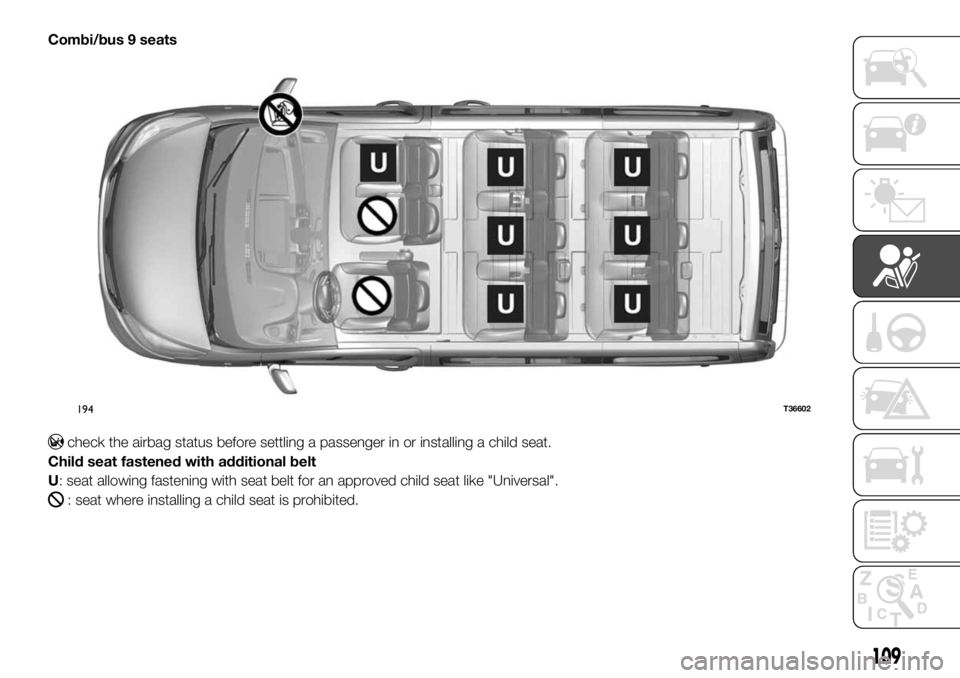
Combi/bus 9 seats
check the airbag status before settling a passenger in or installing a child seat.
Child seat fastened with additional belt
U: seat allowing fastening with seat belt for an approved child seat like "Universal".
: seat where installing a child seat is prohibited.
194T36602
109
Page 112 of 228
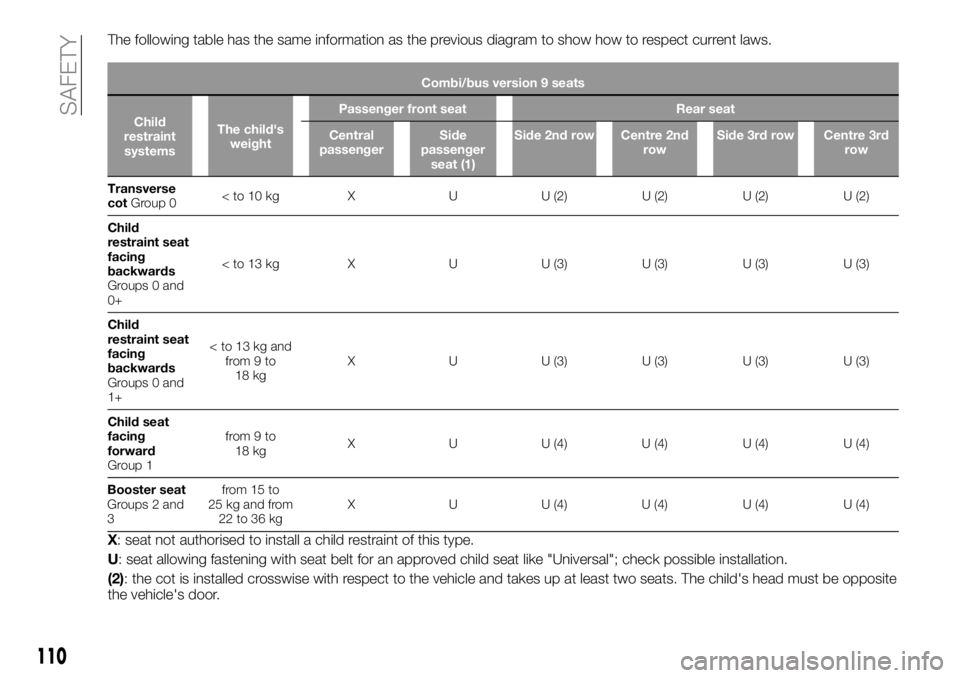
The following table has the same information as the previous diagram to show how to respect current laws.
Combi/bus version 9 seats
Child
restraint
systemsThe child's
weightPassenger front seat Rear seat
Central
passengerSide
passenger
seat (1)Side 2nd row Centre 2nd
rowSide 3rd row Centre 3rd
row
Transverse
cotGroup 0< to 10 kg X U U (2) U (2) U (2) U (2)
Child
restraint seat
facing
backwards
Groups 0 and
0+< to 13 kg X U U (3) U (3) U (3) U (3)
Child
restraint seat
facing
backwards
Groups 0 and
1+
18 kgX U U (3) U (3) U (3) U (3)
Child seat
facing
forward
Group 1from 9 to
18 kgX U U (4) U (4) U (4) U (4)
Booster seat
Groups 2 and
3from 15 to
25 kg and from
22 to 36 kgX U U (4) U (4) U (4) U (4)
X: seat not authorised to install a child restraint of this type.
U: seat allowing fastening with seat belt for an approved child seat like "Universal"; check possible installation.
(2): the cot is installed crosswise with respect to the vehicle and takes up at least two seats. The child's head must be opposite
the vehicle's door.
110
SAFETY
Page 113 of 228

(3): move the front seat as far forward as possible to install the child seat backwards from driving direction, then move it back
to maximum so it does not come into contact with the child seat.
(4): child seat facing forward: position the child seat backrest in contact with the seat backrest. In any case, remove the rear
seat headrest that the child seat is positioned against. This should be done before positioning the child seat (please see the
paragraph "Rear headrest" in chapter "Knowing your vehicle"). Do not move the seat in front of the child back more than half
the distance and do not incline it more than 25°.
111
Page 114 of 228
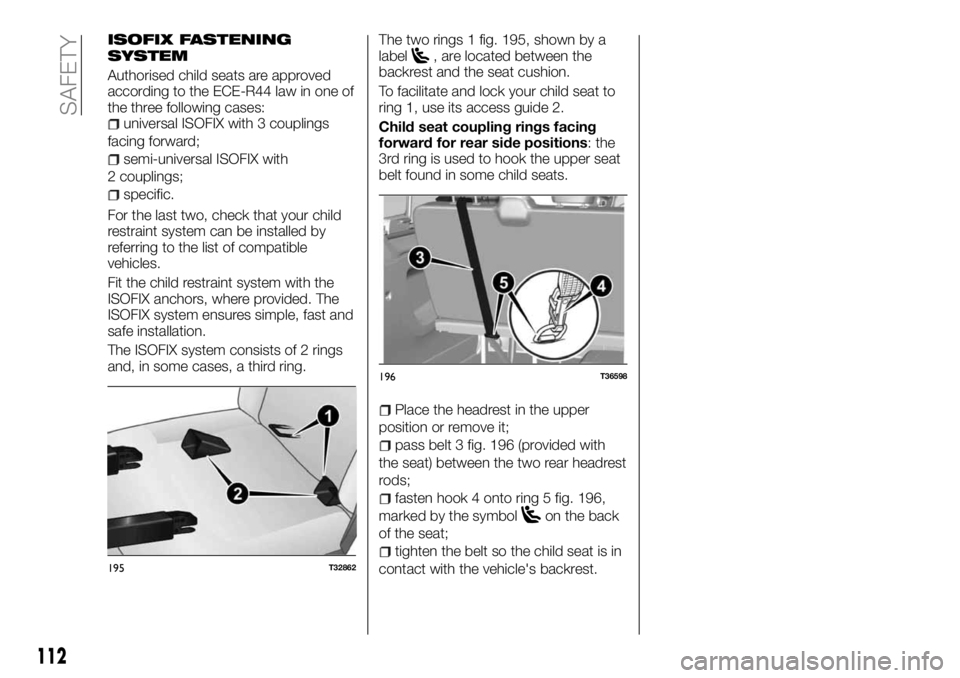
ISOFIX FASTENING
SYSTEM
Authorised child seats are approved
according to the ECE-R44 law in one of
the three following cases:
universal ISOFIX with 3 couplings
facing forward;
semi-universal ISOFIX with
2 couplings;
specific.
For the last two, check that your child
restraint system can be installed by
referring to the list of compatible
vehicles.
Fit the child restraint system with the
ISOFIX anchors, where provided. The
ISOFIX system ensures simple, fast and
safe installation.
The ISOFIX system consists of 2 rings
and, in some cases, a third ring.The two rings 1 fig. 195, shown by a
label
, are located between the
backrest and the seat cushion.
To facilitate and lock your child seat to
ring 1, use its access guide 2.
Child seat coupling rings facing
forward for rear side positions: the
3rd ring is used to hook the upper seat
belt found in some child seats.
Place the headrest in the upper
position or remove it;
pass belt 3 fig. 196 (provided with
the seat) between the two rear headrest
rods;
fasten hook 4 onto ring 5 fig. 196,
marked by the symbol
on the back
of the seat;
tighten the belt so the child seat is in
contact with the vehicle's backrest.195T32862
196T36598
112
SAFETY
Page 115 of 228
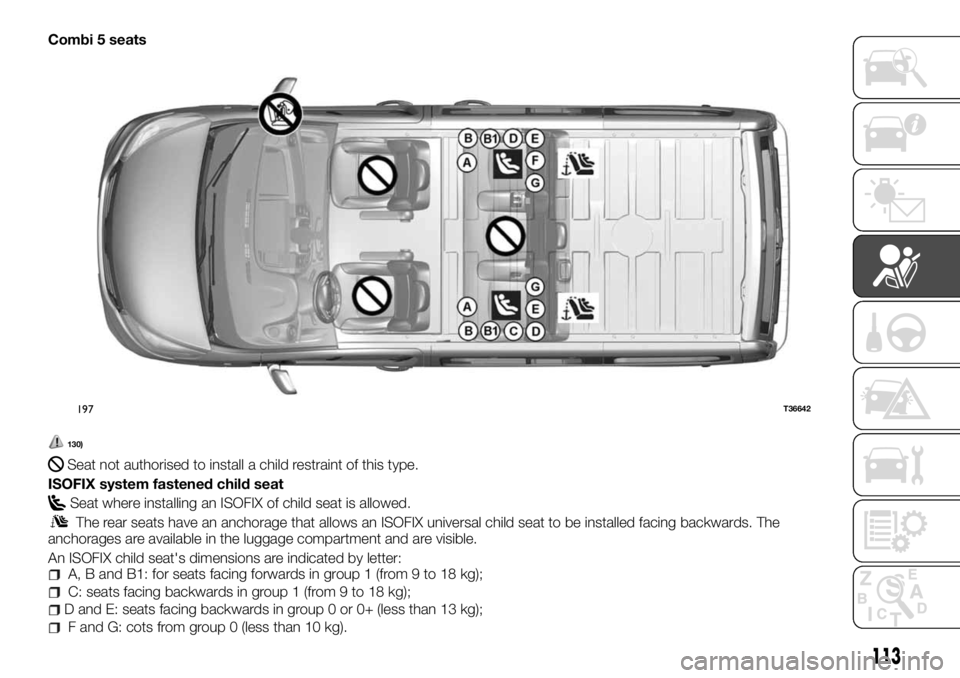
Combi 5 seats
130)
Seat not authorised to install a child restraint of this type.
ISOFIX system fastened child seat
Seat where installing an ISOFIX of child seat is allowed.
The rear seats have an anchorage that allows an ISOFIX universal child seat to be installed facing backwards. The
anchorages are available in the luggage compartment and are visible.
An ISOFIX child seat's dimensions are indicated by letter:
A, B and B1: for seats facing forwards in group 1 (from 9 to 18 kg);
C: seats facing backwards in group 1 (from 9 to 18 kg);
D and E: seats facing backwards in group 0 or 0+ (less than 13 kg);
F and G: cots from group 0 (less than 10 kg).
197T36642
113
Page 116 of 228
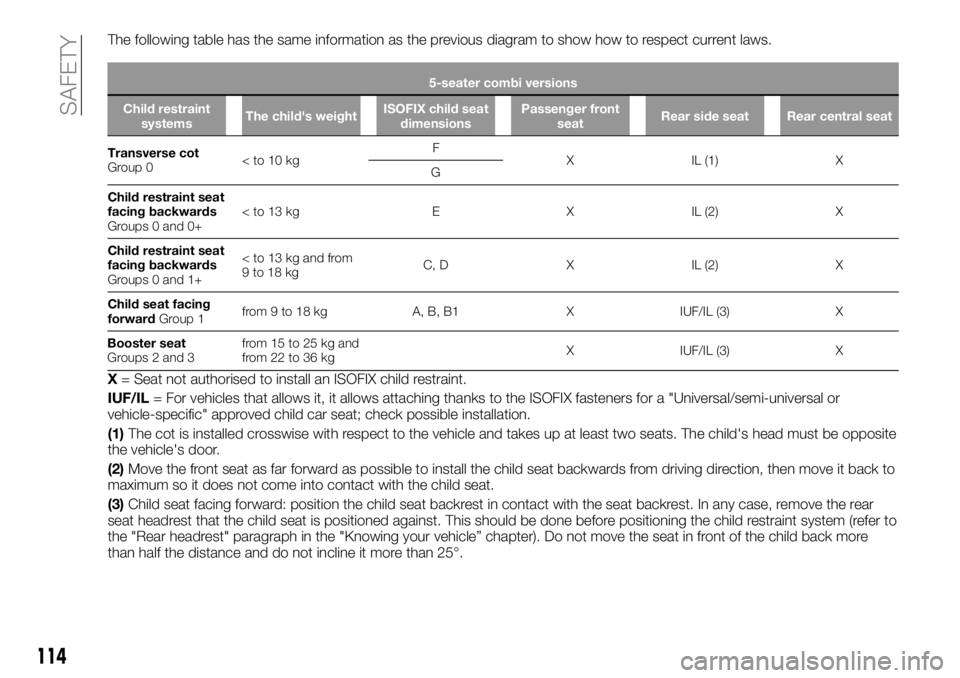
The following table has the same information as the previous diagram to show how to respect current laws.
5-seater combi versions
Child restraint
systemsThe child's weightISOFIX child seat
dimensionsPassenger front
seatRear side seat Rear central seat
Transverse cot
Group 0
G
Child restraint seat
facing backwards
Groups 0 and 0+
facing backwards
Groups 0 and 1+
Child seat facing
forwardGroup 1from 9 to 18 kg A, B, B1 X IUF/IL (3) X
Booster seat
Groups 2 and 3from 15 to 25 kg and
from 22 to 36 kgX IUF/IL (3) X
X= Seat not authorised to install an ISOFIX child restraint.
IUF/IL= For vehicles that allows it, it allows attaching thanks to the ISOFIX fasteners for a "Universal/semi-universal or
vehicle-specific" approved child car seat; check possible installation.
(1)The cot is installed crosswise with respect to the vehicle and takes up at least two seats. The child's head must be opposite
the vehicle's door.
(2)Move the front seat as far forward as possible to install the child seat backwards from driving direction, then move it back to
maximum so it does not come into contact with the child seat.
(3)Child seat facing forward: position the child seat backrest in contact with the seat backrest. In any case, remove the rear
seat headrest that the child seat is positioned against. This should be done before positioning the child restraint system (refer to
the "Rear headrest" paragraph in the "Knowing your vehicle” chapter). Do not move the seat in front of the child back more
than half the distance and do not incline it more than 25°.
114
SAFETY
Page 117 of 228
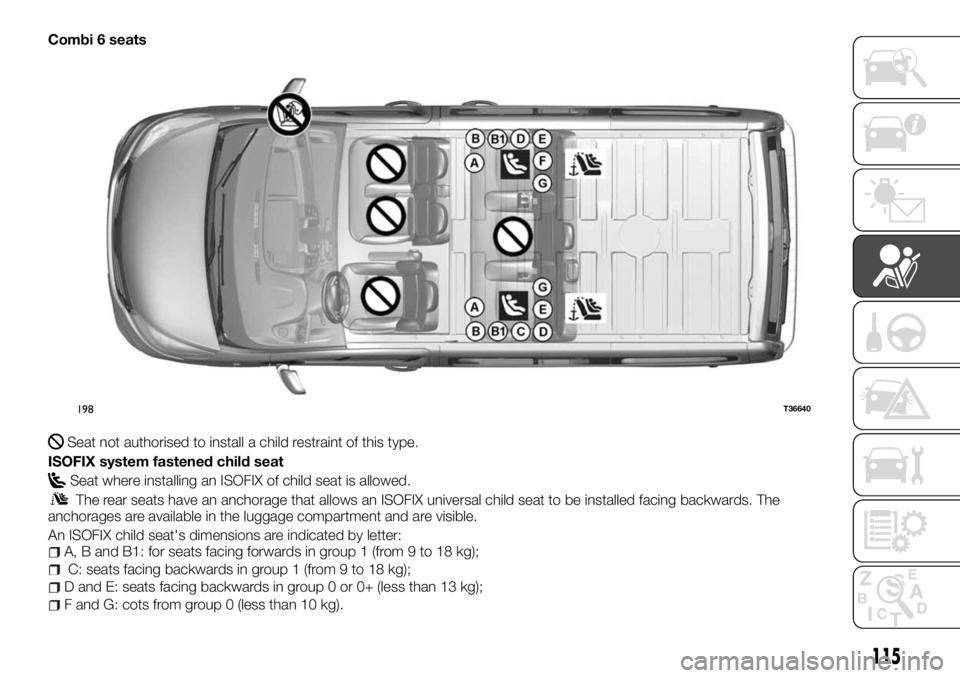
Combi 6 seats
Seat not authorised to install a child restraint of this type.
ISOFIX system fastened child seat
Seat where installing an ISOFIX of child seat is allowed.
The rear seats have an anchorage that allows an ISOFIX universal child seat to be installed facing backwards. The
anchorages are available in the luggage compartment and are visible.
An ISOFIX child seat's dimensions are indicated by letter:
A, B and B1: for seats facing forwards in group 1 (from 9 to 18 kg);
C: seats facing backwards in group 1 (from 9 to 18 kg);
D and E: seats facing backwards in group 0 or 0+ (less than 13 kg);
F and G: cots from group 0 (less than 10 kg).
198T36640
115
Page 118 of 228
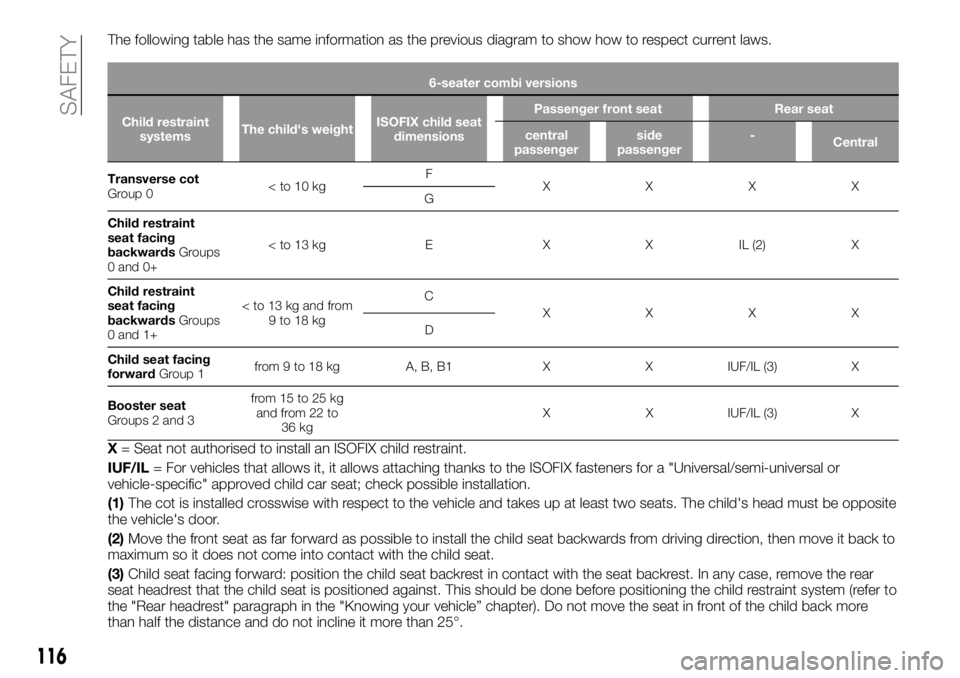
The following table has the same information as the previous diagram to show how to respect current laws.
6-seater combi versions
Child restraint
systemsThe child's weightISOFIX child seat
dimensionsPassenger front seat Rear seat
central
passengerside
passenger-
Central
Transverse cot
Gr
oup 0
G
Child restraint
seat facing
backwardsGroups
0 and 0+
seat facing
backwardsGroups
0 and 1+
XXXX
D
Child seat facing
forwardGroup 1from 9 to 18 kg A, B, B1 X X IUF/IL (3) X
Booster seat
Groups 2 and 3from 15 to 25 kg
and from 22 to
36 kgX X IUF/IL (3) X
X= Seat not authorised to install an ISOFIX child restraint.
IUF/IL= For vehicles that allows it, it allows attaching thanks to the ISOFIX fasteners for a "Universal/semi-universal or
vehicle-specific" approved child car seat; check possible installation.
(1)The cot is installed crosswise with respect to the vehicle and takes up at least two seats. The child's head must be opposite
the vehicle's door.
(2)Move the front seat as far forward as possible to install the child seat backwards from driving direction, then move it back to
maximum so it does not come into contact with the child seat.
(3)Child seat facing forward: position the child seat backrest in contact with the seat backrest. In any case, remove the rear
seat headrest that the child seat is positioned against. This should be done before positioning the child restraint system (refer to
the "Rear headrest" paragraph in the "Knowing your vehicle” chapter). Do not move the seat in front of the child back more
than half the distance and do not incline it more than 25°.
116
SAFETY
Page 119 of 228
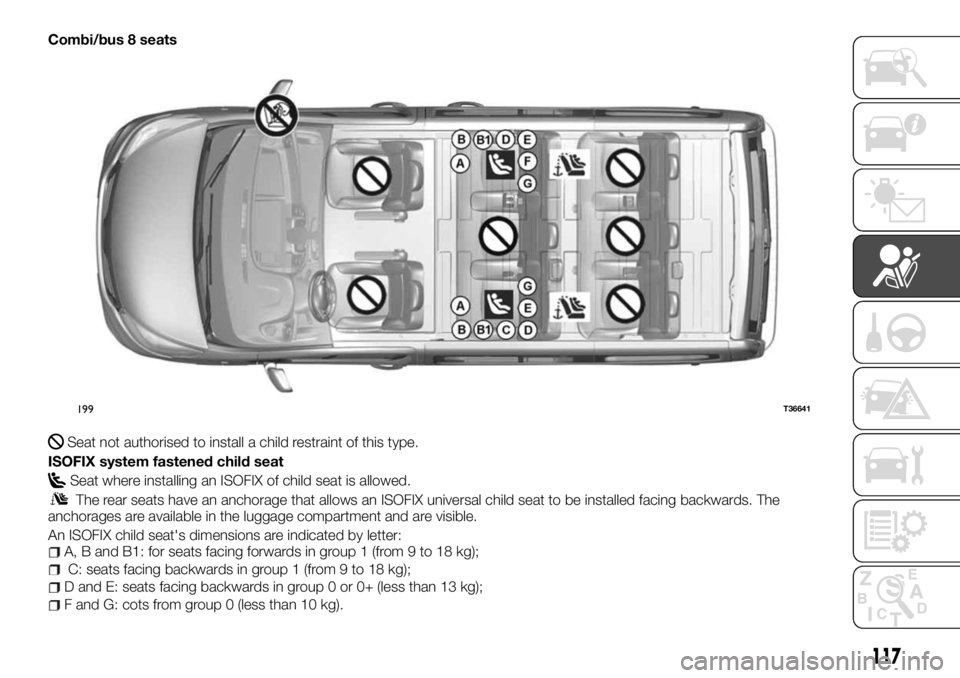
Combi/bus 8 seats
Seat not authorised to install a child restraint of this type.
ISOFIX system fastened child seat
Seat where installing an ISOFIX of child seat is allowed.
The rear seats have an anchorage that allows an ISOFIX universal child seat to be installed facing backwards. The
anchorages are available in the luggage compartment and are visible.
An ISOFIX child seat's dimensions are indicated by letter:
A, B and B1: for seats facing forwards in group 1 (from 9 to 18 kg);
C: seats facing backwards in group 1 (from 9 to 18 kg);
D and E: seats facing backwards in group 0 or 0+ (less than 13 kg);
F and G: cots from group 0 (less than 10 kg).
199T36641
117
Page 120 of 228
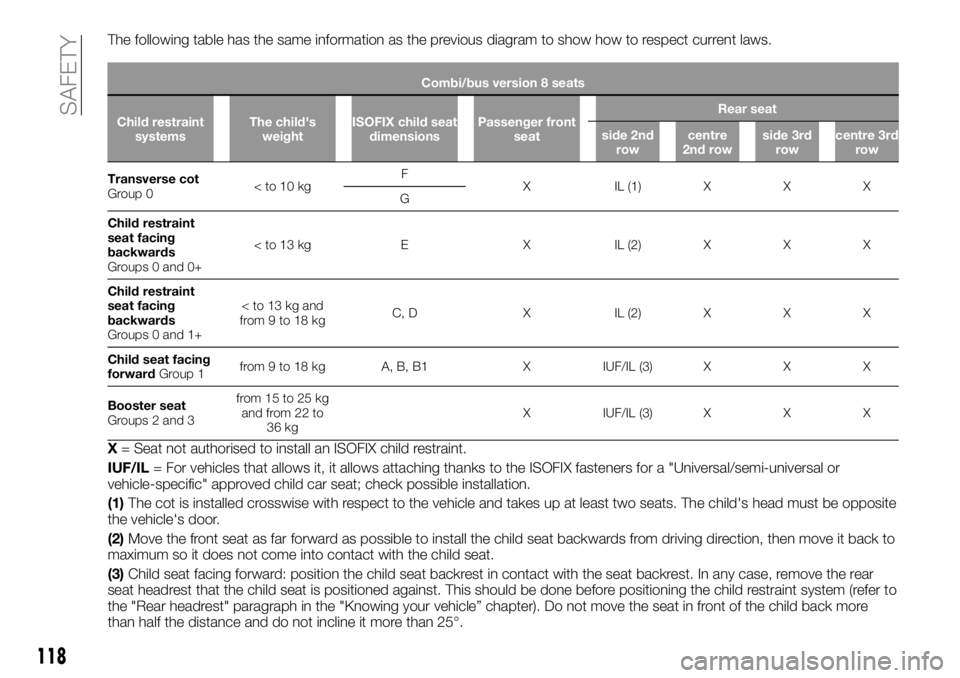
The following table has the same information as the previous diagram to show how to respect current laws.
Combi/bus version 8 seats
Child restraint
systemsThe child's
weightISOFIX child seat
dimensionsPassenger front
seatRear seat
side 2nd
rowcentre
2nd rowside 3rd
rowcentre 3rd
row
Transverse cot
Gr
oup 0
G
Child restraint
seat facing
backwards
Groups 0 and 0+
seat facing
backwards
Groups 0 and 1+
Child seat facing
forwardGroup 1from 9 to 18 kg A, B, B1 X IUF/IL (3) X X X
Booster seat
Groups 2 and 3from 15 to 25 kg
and from 22 to
36 kgX IUF/IL (3) X X X
X= Seat not authorised to install an ISOFIX child restraint.
IUF/IL= For vehicles that allows it, it allows attaching thanks to the ISOFIX fasteners for a "Universal/semi-universal or
vehicle-specific" approved child car seat; check possible installation.
(1)The cot is installed crosswise with respect to the vehicle and takes up at least two seats. The child's head must be opposite
the vehicle's door.
(2)Move the front seat as far forward as possible to install the child seat backwards from driving direction, then move it back to
maximum so it does not come into contact with the child seat.
(3)Child seat facing forward: position the child seat backrest in contact with the seat backrest. In any case, remove the rear
seat headrest that the child seat is positioned against. This should be done before positioning the child restraint system (refer to
the "Rear headrest" paragraph in the "Knowing your vehicle” chapter). Do not move the seat in front of the child back more
than half the distance and do not incline it more than 25°.
118
SAFETY